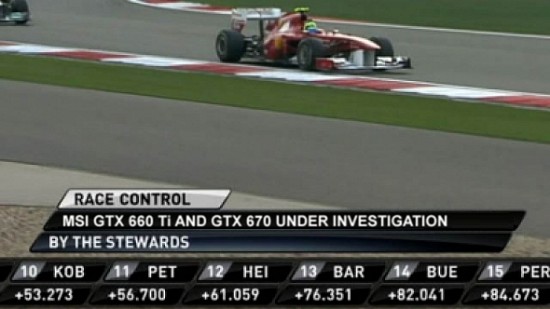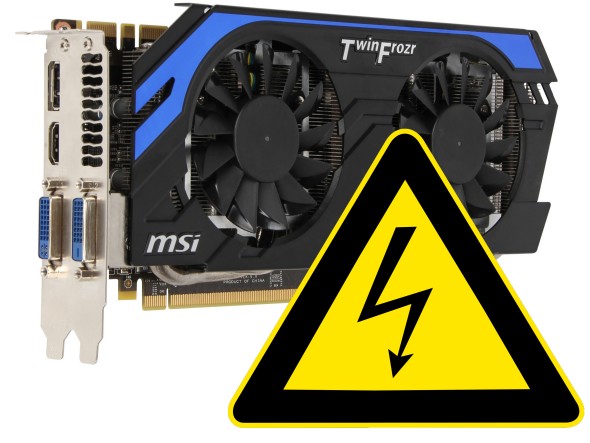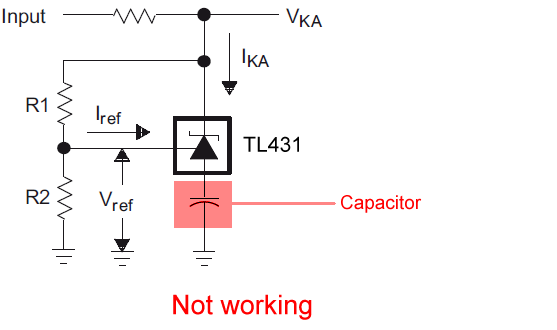MSI Caught Overvolting GTX 660 Ti, 670 Power Edition Cards
If a company changes its product in the middle of a production run after an error becomes public, you know something’s fishy. If Nvidia steps in as well, that’s a good indication there’s something serious going on. Here’s what happened at MSI.
Our colleagues over at Tom’s Hardware Germany seem to have caught MSI red handed, overvolting the GPUs on the GTX 660 Ti and GTX 670 Ti Power Edition boards (Google Translate) to achieve a higher and longer lasting GPU boost state by basically circumventing the PWM controller. In other words, MSI was cheating. Perhaps no one would ever have known if it hadn’t been for one side effect. The increased voltage can cause the system to refuse to POST.
A quick search revealed that there are a number of threads on message boards where users report such problems, and our initial research led us to conclude that it was indeed these specific models causing trouble. What was obviously intended to provide a competitive benefit in benchmarks is apparently now backfiring.
To verify our findings and analyze their cause, we conducted some of our own research, enlisting the help of our own UK community member starcraftgod who was also affected by the issue. After comparing notes and measurements, we took a closer look at the circuit board itself. What we found there was unexpected to say the least, and it’s almost hard to believe an engineer would create something like this on purpose. In short, the PWM controller on said cards is overvolted by up to 88 percent using a small alteration to its power supply, which leads to the chip running way outside of its specifications and at significantly deviating characteristic lines. This means that too much voltage is being applied to the GPU in general and the voltage reduction under load (droop) is not as large as it should be -- and that's just one side of the story. The other is that MSI’s tinkering can cause serious side effects.
So what’s happening? A small component completely superfluous to the normal circuit in one of the ground connections causes major overvoltage in the PWM chip in question – instead of the 5 volts specified by Richtek, the chip is hit with up to 9.3 volts. That can’t be good for its life expectancy in the long run and also causes the issues we mentioned above. In combination with some PSUs, the system will be unable to start up if the 12 volt rail has to provide more that 12 volts to one of the PowerEdition models (even within the ATX spec). In other cases, MSI’s circuit trick can trigger a black screen or cause a driver crash when a change of load occurs. We find it hard to believe in a design accident here, since the circuit in question is a standard design – if implemented correctly.
MSI got back to us with a very enlightening statement. Here’s an excerpt:
We are currently not aware of any other vendor providing this same level of performance and we’ve worked with NVIDIA to ensure that new production models will limit this free overclock boost you currently get. Our new production models with normal GPU Boost function will be on sale next month.
Reading between the lines, we can gather that Nvidia is none too pleased with MSI going off on their own. The full article on Tom’s Hardware Germany (Google Translate) covers the topic in more depth.
Get Tom's Hardware's best news and in-depth reviews, straight to your inbox.

Igor Wallossek wrote a wide variety of hardware articles for Tom's Hardware, with a strong focus on technical analysis and in-depth reviews. His contributions have spanned a broad spectrum of PC components, including GPUs, CPUs, workstations, and PC builds. His insightful articles provide readers with detailed knowledge to make informed decisions in the ever-evolving tech landscape
-
pjmelect With the capacitor in the position shown in the circuit diagram the voltage regulator will not be doing anything and would not be needed. I think that this is a layout error and not deliberate and should have been picked up when the board was tested by the manufacture. It is amazing that the board worked at all with this error.Reply
It does however raise a more serious point that as the development cycle time reduces between boards being released the testing of the designs is being cut back on. -
Darkerson Having used MSI products in the past, I have to say Im very disappointed in them and will probably not be using them again.Reply -
csf60 What the hell were they thinking??? Didn't they test these cards before release or what?Reply -
alidan so what was the end result of this in a gameing sense?Reply
not a system wont boot, or card dies sooner, lets assume everything went fine
what did the card gain? -
zero messiah *we’ve worked with NVIDIA to ensure that new production models will limit this FREE overclock boost you currently get*Reply
On behalf of consumers everwhere, i would like to thank you MSI for trying to make us feel guilty.
And in the future, i will try not to feel entitled to having a working graphics card.
`Sincerely,
Joe Q Public.
PS. Burn in hell @ 9.3 volts. -
proffet BUSTED....Reply
And I have been a MSi TwinFrozr and PE (Power Edition) nVidia models fan in the past.
I wonder if some legal action is soon to come like a class-action or something.?
Consumers mad because they blew their hardware up.. -
officeguy My momma told me if I don't have anything good to say, don't say it at all. So, I am not going to say anything.Reply


